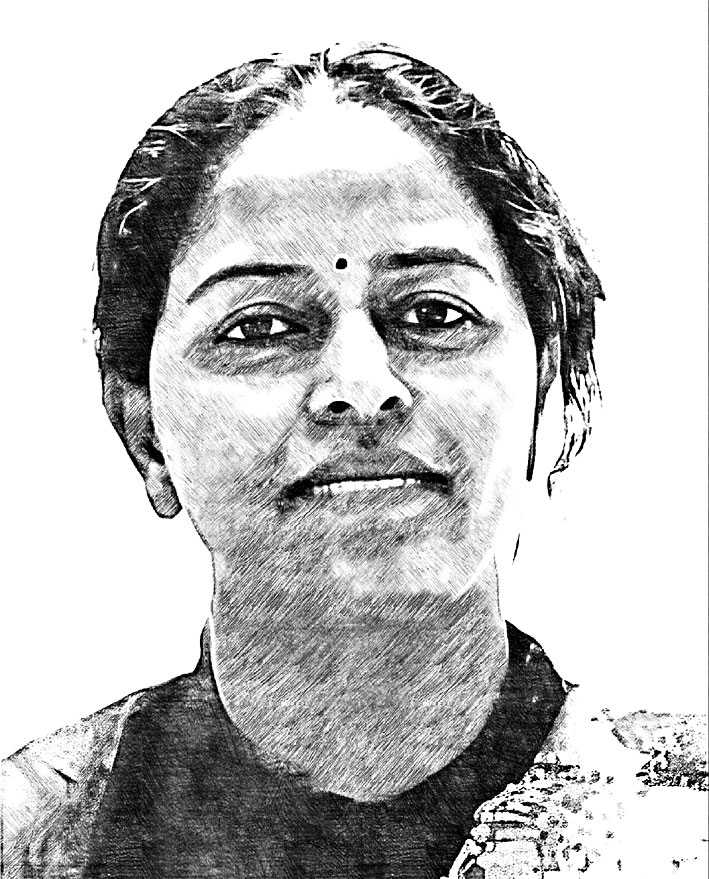Integrating discrimination into MPI can provide crucial information on why there remain multidimensionally poor households in certain groups
Published Date – 11:59 PM, Sat – 21 October 23

By Arya Jash, Gummadi Sridevi, Amalendu Jyotishi
In 2011, the Human Development Report introduced the Multidimensional Poverty Index (MPI) in order to align poverty alleviation with the attainment of the Sustainable Development Goals. The pioneering work in constructing the index was of Sabina Alkire and James Foster (2008).
The MPI explains poverty at a household level. However, the indicators scarcely explain the utilisation or quality dimensions beyond the presence or absence of the indicator concerned. It does not differentiate across subgroups, failing to measure discrimination. Adding discrimination brings the element of social dimension-based poverty into an instrument concerned with unit-level measurement. Discrimination in India has immense consequences towards economic outcomes. Integrating discrimination into the MPI could provide crucial information on why there remain multi-dimensionally poor households in certain groups and visible inter-social group disparities, accentuating our understanding of poverty across groups.
NITI Aayog Version
In 2019, the NITI Aayog published the India National Multidimensional Poverty Index: Baseline Report, thus signalling its official adoption by the Indian government. However, in a country with as diverse and complex a social structure as India, simply applying the new measure would not be enough to make informed policy decisions regarding poverty alleviation.
In a country as diverse and complex as India, simply applying the new measure will not be enough to make informed policy decisions regarding poverty alleviation
The NMPI devised by the NITI Aayog was a mammoth project with expert help from the UNDP (United Nations Development Programme) and OPHI (Oxford Poverty and Human Development Initiative), and the coordination of 12 governmental departments and ministries. The methodology used is consistent with that of the global MPI, the Alkire-Foster methodology, wherein an individual/household is assigned individual weighted deprivation scores based on whether they meet a certain requirement for basic indicators, such as years of schooling and nutrition. They are then aggregated to form a score which identifies that unit as multi-dimensionally poor or not. In the case of National MPI (NMPI), there were slight tweaks done to the deprivation indicators.
The database used to construct the MPI is the completed NFHS-4 survey. This takes after a global MPI study conducted for India in 2018 in which India’s improvement in multidimensional poverty indicators between 2005-06 and 2015-16 was measured using NFHS-3 and NFHS-4 datasets respectively. There is not much change except a few altered deprivation indicators. The alteration of the indicators has improved the value of NMPI relative to Global MPI, despite both using the same dataset. To gain a greater insight into India’s multidimensional poverty, one must alter the indicators to a more meaningful context; such as adding a social dimension, a measure of access and utilisation, among others.
Criticism of Living Standard Indicators
As it stands, in the ‘Standard of Living’ dimension, the indicators used are devoid of quality of public service delivery and lack accountability. Examples include bank account indicator, which counts only the presence of a bank account; sanitation, which registers only the availability but not usage of toilets by households; cooking fuel, which measures just having an LPG fuel source; electricity, which accounts for only having an electricity connection.
Instead of increasing the number of indicators, splitting the Standard of Living dimension ensures a more equitable distribution of the weights among indicators
Solutions to the above problems lie in broadening the scope of questions asked. To not stop at a household having or not having a particular amenity, but ask — ‘how frequently do power cuts happen?’; ‘how often are you able to refill LPG when needed?’; ‘how often do you access your bank account for transactions, online or otherwise?’; ‘are sanitation facilities easy to utilise, and if not, what are the obstacles?; and similarly for other indicators.
The key to measuring these would be to parameterise them according to a standard, such that inability to access and use an amenity at a certain level can be viewed as deprivation; and weights to indicators assigned accordingly. Opening up the indicators to measure access and utilisation will shine a light on households and vulnerable groups who are denied basic services, and how severe their deprivations are. This would also reveal the specific areas where public policy succeeds or fails in its delivery of basic amenities. This change can only occur gradually, and current national surveys are not tasked to capture all the specifics. It might require the aid of digital public good infrastructure that the government intends to bring in en masse. Following this course would increase the wealth of information available to researchers and policymakers alike for targeting multidimensional poverty.
Is MPI Adjustable?
In the Baseline Report, there is no mention of incorporating a social dimension into the measure to account for marginalised or vulnerable social groups comprising caste, tribe, religion, gender, etc. In India, especially in rural spaces, social standing determined by these factors plays a significant role in access to welfare. A study in 2011 showed that in India, despite advances made by all groups, the access to and utilisation of productive resources, such as education, skills and capital, remain closely associated with caste. It is thus clear that the adopted MPI measure must account for how belonging to a vulnerable group affects a household’s multidimensional poverty.
A study showed that access to and utilisation of productive resources, such as education, skills and capital remain closely associated with caste
The Chilean MPI (MPI-CL) provides important insights into how MPI can be adjusted in a country context. Based on the initial MPI-CL, and the results of the National Socioeconomic Characterisation (Casen) Survey conducted in 2015 (which measured deprivations associated with local environment and social networks available to households), the index was adjusted in 2016 (Figure 2). The ‘Living Standards’ dimension transformed into ‘Employment and social security’, ‘Housing and local environment’, ‘Networks and social cohesion’. The share of the multidimensionally poor population in Chile measured by MPI-CL 2.0 showed an increase for 2015 and 2017 as compared with the first version, which showed the share declining (Figure 3). Thus, adjusting dimensions broadens the scope of the country-specific multidimensional poverty measure and makes it more inclusive, bringing in household deprivations, which would be overlooked. This proves that the MPI can be adjusted to suit a country’s requirements. It should be possible for India’s NMPI.

Measuring Discrimination
We offer a few suggestions on how the MPI can be used/altered:
The MPI is constructed by aggregating only the vulnerable groups, and compared with the already existing MPI values at various levels utilising data present in the NFHS. Much like how the components of the Gender Inequality Index are calculated separately for each gender, there can be MPI calculated per social group for each regional level, aggregated to form a ‘Social Group’ MPI (SGM). The aggregation could involve weighting each group by population share. A comparison between the values of NMPI and SGM should show how multidimensional poverty differently impacts vulnerable groups as opposed to overall assessments.
- Going Beyond Availability: Access to and delivery of government programmes on the basis of social group
One way forward is to measure household access to government welfare programmes, taking into consideration the vulnerable groups’ populations. This new dimension counts the severity of deprivation as being greater if a vulnerable household does not have access to government programmes. The programmes considered here would be those provided to fulfil basic needs: schemes which guarantee the basic entitlements of the household (food, accommodation, employment, sanitation, etc). A lack of access parameter, ranging from one-third to all schemes could signify that the vulnerable household is deprived as a function of their social standing. The advantages are: since it looks at the number of beneficiaries, it is quantifiable as an indicator for multidimensional poverty making it easier to assess policy effectiveness.
However, this method is not without difficulties: how to distinguish this dimension in the case of non-vulnerable households since lack of access and utilisation is a general issue, and could be overlooked. This problem arises because the MPI is measured ground-up, from the household level. Collecting data regarding scheme memberships at the household level will be time-consuming and tedious. Detailed questions regarding this aspect would need to be incorporated into national-level surveys (like questions NFHS has on health schemes for households) to obtain relevant data. A crucial aspect for debate is the choice of schemes, which would serve to inform this dimension. Further study is required to select the lack of access to which multiple welfare schemes signify critical deprivation due to social standing.
The above discussion brings up a common point: the NMPI has limited effectiveness in capturing the full range of deprivations in the Indian context. Furthermore, any ‘improvement’ to the current index requires either an enhancement of existing indicators, or addition of another dimension, or both. Thus, an alternative approach to the NMPI would be to take a step back and decompose the ‘Standard of Living’ dimension into a set of more relevant dimensions. This dimension is more amenable to adaptability, and has the most number of indicators, reducing their impact on deprivation measurement. Instead of simply increasing the number of indicators, splitting the dimension ensures a more equitable distribution of the weights among indicators, ensuring that deprivations have a more substantial impact on the overall value of the index.
A possible reimagining of the Standard of Living dimension could involve splitting it into two dimensions, ‘Utilisation of Amenities’ and ‘Welfare Access and Social Exclusion’. With this, the number of dimensions becomes four from the original three which are Health, Education and Standard of Living. (Fig 1) The indicators under these two new dimensions would be able to cover the standard of living, as well as quality of usage, accessibility and availability of welfare schemes to different households as discussed prior. The total weightage as well as the ‘multidimensionally poor’ criterion would be adjusted accordingly. The proposed dimensions are demonstrative, and are subject to change upon further discussion and research.
Widening Ambit
The way forward for the NMPI is to make changes if multidimensional poverty measurement is to work effectively in India. If any of the above measures were to be successfully integrated into the multidimensional poverty measurement programme, it would widen its ambit, showing that vulnerable groups suffer deprivations to a greater extent, and help augment the NMPI. This will provide policymakers with a deeper understanding of how access and the social dimension interconnect with multidimensional poverty and help in developing initiatives effectively to address the areas of concern, ensuring no one is left behind.
Opening up the indicators to measure access and utilisation will shine a light on households and vulnerable groups who are denied basic services
Any alterations to the MPI will be up for debate, and further research is required to figure out a concrete way to incorporate factors such as discrimination or access and utilisation into the measure. In India, where ‘non-economic’ factors such as gender, religion and social status affect and determine so much of economic activity and well-being, measures such as the NMPI must be adaptively used to the fullest to deliver better outcomes to those in need.








